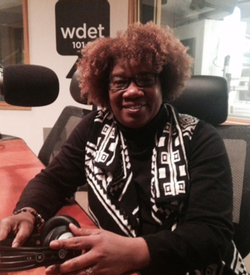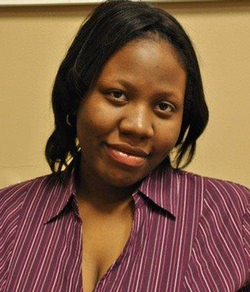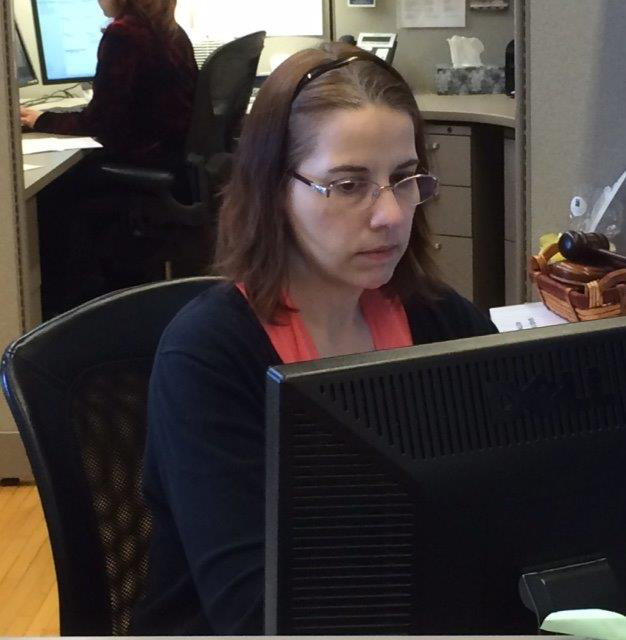Detroit by the numbers – the truth about poverty
Delphia Simmons meets a lot of people in financial distress.
In her job at the Coalition on Temporary Shelter (COTS) in Detroit’s Midtown neighborhood, she’s witness to the myriad plot twists that land people in the homeless shelter from throughout the metro area. From job loss and chronic unemployment, to mortgage and tax foreclosure, to unexpected expenses, medical crises and domestic violence, she's seen it all.
“We have a lot of heartbreaking stories,” said Simmons, director of COTS’s Passport to Self-Sufficiency program.
Residents there are without the safety net of steady income that’s high enough to pay for life’s basic needs: housing, food, transportation and health care. Simmons says she sees people’s direct paths from being simply financially challenged to facing the more serious societal issues of homelessness, hunger and long-term unemployment.
“If we could get ahead of it... we could actually prevent homelessness from happening, which is what you really want to do, prevent it before it happens,” she said. “The face of homelessness is not the face of the man holding the sign at the freeway exit anymore. It is families.”
Listen to an interview with Delphia Simmons
Who’s poor?
The federal government defines poverty in terms of household income. The measure is based on the estimated cost of food for a particular household type, multiplied by three.
“It's based on different family sizes and number of children; there’s this complex matrix,” said Erica Raleigh, director of Data Driven Detroit.
No other household budget line items are taken into account in the definition. The measure is used across the continental United States with no variation allowing for geographic differences in the cost of living. The definition has not changed for decades.
Poverty thresholds are set very low. For example, a single person was considered at or below the federal poverty threshold if they earned $12,316 or less annually in 2014. For a family of two adults and two children, the poverty threshold is $24,008 of annual income.
A host of federal, state and local assistance programs determine eligibility for their services based on how household income compares to the poverty threshold. Among the approximately 30 federal programs are Head Start, a preschool program, the Supplemental Nutrition Assistance Program (or SNAP, better known as food stamps) and free and reduced lunch programs in schools.
State programs include the Children’s Health Insurance Program and the Michigan Family Independence Program. A local example includes a program created as a part of Detroit’s bankruptcy settlement. The program would set up a fund to reduce pension cuts to some retirees who fall below 140 percent of the federal poverty level.
“As a component of the state contribution agreement [for $195 million toward pension funding], it was very important to state officials that no retiree be pushed into poverty,” former Detroit Emergency Manager Kevyn Orr said during the city’s bankruptcy trial.
About 2,200 people applied for this program and roughly 1,700 qualified, according to Terry Stanton, spokesman for the Michigan Department of Treasury.
Debating the definition
How the federal poverty threshold is set is a topic of debate. Kyle DuBuc, director of public policy and advocacy at the United Way for Southeastern Michigan, criticized the federal poverty threshold as being too low to reflect the current reality of how much families need to earn to be financially stable.
“We have an archaic idea of what it means to be in poverty. The poverty level is not reflecting the actual needs of families,” DuBuc said. “To actually address this and make sure that we have families that are financially stable and a thriving and robust state economy, we all have to look at the actual needs of families and ensure that they’re being met.”
How many people are poor?
Based on U.S. Census data, 41 percent of Detroit residents live at or below the federal poverty threshold.
Among the nation’s 20 biggest cities, Detroit has the high poverty rate. Among Michigan’s 10 largest municipalities, it’s second to Flint.
In Detroit’s metro area and the rest of the state, 17 percent of people live at or below the federal poverty threshold. Nationally, that population is 16 percent.
Within Detroit, there are census tracts with unusually high poverty rates: on the city’s east side, a neighborhood near the Chrysler-Jefferson North Assembly Plant has a family poverty rate of 83 percent. Along Detroit’s eastside border with upscale Grosse Pointe Park, one tract has a 72 percent of families living in poverty. On the city’s west side, the Brightmoor neighborhood has a section where two-thirds of families exist with household income below the federal poverty threshold.
Outside of Detroit, the region’s highest poverty census tract is in the southwest corner of Taylor (63 percent). Only two other southeast Michigan neighborhoods outside of Detroit have poverty rates above 60 percent: one in Pontiac, another in Highland Park.
Is information accurate?
Data about community poverty are considered some of the most reliable information that can be gleaned about an area’s socioeconomic condition, according to Data Driven Detroit’s Raleigh.
“We’ve measured this fairly consistently over time, so at least comparing back over the decades or a year ago, 10 years ago, we can be fairly confident that the data were gathered in the same way,” she said.
But while poverty data may be accurate and reliable, they create only a partial picture of a community’s economic situation. They don't tell the full story of what poverty and low income mean for individuals.
“Data can’t capture all of that, right? Numbers can’t tell the whole human experience,” Raleigh said.
Who’s poor? Part one
Detroiter Emaginae Hicks had a job as a waitress after high school to support her two children. She was making it work. Living with her grandmother, she helped as she could with rent payments, spending most of her money on her children.
“Being a waitress you don’t make a lot of money, so you have to be a saver, and I’m a saver. I buy what’s needed and not what I want, and of course I take care of the kids first and foremost,” Hicks said. “I had to manage that pretty well, and it did good for a minute but around the winter, that’s when business gets cut down.”
Slower times at the restaurant meant fewer shifts meant lower income last year. Then her grandmother went into a medical facility and living in her home wasn’t an option any more. Hicks and her boyfriend found friends to live with, but then that house went into foreclosure. Pregnant, with limited job options, Hicks saw no other options but the shelter at COTS.
The roughly $11,000 she made in 2014 is the most she’s ever made in a year, and it puts her far below the federal poverty threshold. But she won’t say she’s poor.
“I just say I’m less fortunate. I’m not at will to do what I’m used to doing,” she said. “Maybe some people feel if they don’t have this, a certain amount of money, that they’re used to having in their hand that they’re poor but I don’t believe in that.”
After her child is born this spring, Hicks plans to enroll in a six-month nursing assistant program. She’s got government-provided health insurance and child care along with a Bridge card for some food expenses. She recognizes that taxpayers are making an investment in her.
“Now that I see the situation I’m in, I have to push myself,” Hicks said. “Some people can have kids and then go out and get them a career but for my situation, I probably needed to have a career first and then kids.”
Survival, Stability, Sustainability
Jessie Robinson doesn't seem like she’s among Michigan’s poor or low-income earners. She is college-educated and makes about $40,000 annually as an office administrator at the Capital Area United Way in Lansing.
But take a closer look at what that salary supports. Her doctorate-holding husband hasn’t been able to work since a car accident three years ago. She had taken a new job just before the wreck, and was still paying for a health care policy before her new employer’s took effect. Medical bills not covered by insurance currently eat up about a quarter of her monthly income. One of her three step-children lives at home. They have one car, an older model. After the accident, they moved from an outlying area into Lansing where they could use public transportation. But when she chose a house with lower rent, she didn’t account for the higher utility bills she’d have. She manages her monthly food budget down to about $200. There are student loans and child support payments.
“It’s a struggle to get by on a daily basis, basically,” Robinson said.
Robinson isn’t among the 32 percent of people in Lansing in poverty, according to the U.S. Census, but she’s among the 40 percent of Michigan residents who don’t make enough to cover basic expenses. That's according to a different definition of financial challenge that takes broader cost-of-living factors into account.
The definition is part of the Michigan Association of United Ways’ report on the state’s “ALICE” population. ALICE is an acronym for Asset-Limited, Income-Constrained, Employed. “ALICE seeks to establish what is an actual, just bare bones, basic household survival budget,” said DuBuc, the United Way public policy and advocacy director.
Launched in six states including Michigan, the ALICE project examines the varying costs in each county for five major household budget line items: housing, food, transportation, health care and child care. Based on those costs, the ALICE project defined “Survival” and “Sustainable” household budget levels.
The Survival level is what families need to earn to meet their basic needs, according to the ALICE report.
“There are no frills, there’s no dining out. There’s no unnecessary expenses. It’s basically what a family needs to survive, but if there is a crisis, a family could very well be plunged back into poverty,” DuBuc said.
The Stability level provides for some savings and additional spending such as on education.
“The Stability Budget takes into account that if a family does come into crisis, that they won’t be plunged back into poverty or into a permanent state of financial instability,” DuBuc said.
While about 16 percent of Michigan households are at or below the federal poverty threshold, another 24 percent are considered below the ALICE Stability threshold. Michigan was uniquely hard hit by the Great Recession, and DuBuc sees that reflected in the ALICE report.
The report was, in part, an effort to challenge the federal poverty thresholds, which DuBuc said are too low to represent the financial realities families face across the country.
“All federal agencies use the poverty standard because it’s recognized. But it’s inefficient and
ineffective. We don’t believe we’re building a program that is really addressing the needs of families,” DuBuc said.
The project aims, in part, to create a new, more accurate terminology to use in conversations about the economic challenges faced by families and individuals.
“Families that were stable through most of their lives are now finding themselves under the ALICE threshold,” he said. “While some of the terms – working poor or underemployed – get at a piece of it, they’re not really getting at the expense side of it. We needed to put a new face on it and let people know where these families are and what they look like. The reality is, they’re everywhere and they look like all of us.”
Can poverty be "solved?"
Arthur Jemison has witnessed firsthand how public support can help stabilize the lives of those who literally would otherwise be out on the street.
As Director of Housing and Revitalization for the city of Detroit, he manages the $37 million that comes to the city every year from the U.S. Department of Housing and Urban Development to support housing for low-income people. The federal grants pay for, in part, 3,700 units of public housing and 6,000 Section 8 vouchers, both of which Jemison describes as creating “a real safety net for residents of the city” who are in poverty or close to it.
“If you look at the network of dollars coming into the city,” Jemison said, “those are the dollars that are explicitly designed to fight poverty.”
Jemison, who has worked in Washington D.C. and Massachusetts, joined Detroit Mayor Mike Duggan’s administration late last year. He characterizes his boss’s approach to poverty, at least as it relates to housing policy, as seeking to change the basic philosophy behind rental assistance programs.
"The way the mayor has looked at this with me so far is to say, ‘Either the things we’re doing in housing are a launch pad for low-income households or they’re a safety net, and I want them to be a launch pad.’ You want someone to move into an affordable housing unit in our city, have a stabilized place to live that’s safe and have access to jobs and transportation and school,” he said. “I think that’s the direction that we’re going.”
Ask Jemison what policies can eliminate poverty, and he’s less than utopian.
“We will never have the resources we need to fully win this battle in Detroit. I think we can do well and we can do much better, but I think it’s going to take a regional approach to solving the problem for us to really make progress. So I think the time’s now to do that…(there’s) a real feeling of something new happening in the city and the region,” he said. “I think we’ve got to capitalize on it.”
The Passport to Self-Sufficiency program that Simmons directs at COTS aims to help individuals and families with the side of the poverty equation they can partially control: financial management, health, education and employment.
“When we say self-sufficient, we mean without government support, and so they do have to have a living wage. And so in order to do that, they need a career field and not just a job,” Simmons said.
But she said it will take more than the efforts of nonprofit organizations to end poverty.
“I don’t think any one organization can break it, and I think that’s one of the large misconceptions that we operated under: that it is for the nonprofit or impact sector to break this,” Simmons said. “We need the business sector. We need corporations. We need individuals. We need communities. It’s really something that has to be done together.”
See what new members are saying about why they donated to Bridge Michigan:
- “In order for this information to be accurate and unbiased it must be underwritten by its readers, not by special interests.” - Larry S.
- “Not many other media sources report on the topics Bridge does.” - Susan B.
- “Your journalism is outstanding and rare these days.” - Mark S.
If you want to ensure the future of nonpartisan, nonprofit Michigan journalism, please become a member today. You, too, will be asked why you donated and maybe we'll feature your quote next time!


 Delphia Simmons works for the Coalition on Temporary Shelter (COTS) in Midtown Detroit. (Photo by Sandra Svoboda)
Delphia Simmons works for the Coalition on Temporary Shelter (COTS) in Midtown Detroit. (Photo by Sandra Svoboda) Detroiter Emaginae Hicks work as a waitress barely supported her and her two children, until it didn't. (Photo by Michael Ference)
Detroiter Emaginae Hicks work as a waitress barely supported her and her two children, until it didn't. (Photo by Michael Ference) With a $40,000 salary, Jessie Robinson of Lansing may not seem to fit the poverty profile. But with medical bills from injuries her husband suffered in a car accident, higher utility bills, student loans and a child still at home, budgeting is a struggle. (Courtesy photo)
With a $40,000 salary, Jessie Robinson of Lansing may not seem to fit the poverty profile. But with medical bills from injuries her husband suffered in a car accident, higher utility bills, student loans and a child still at home, budgeting is a struggle. (Courtesy photo)